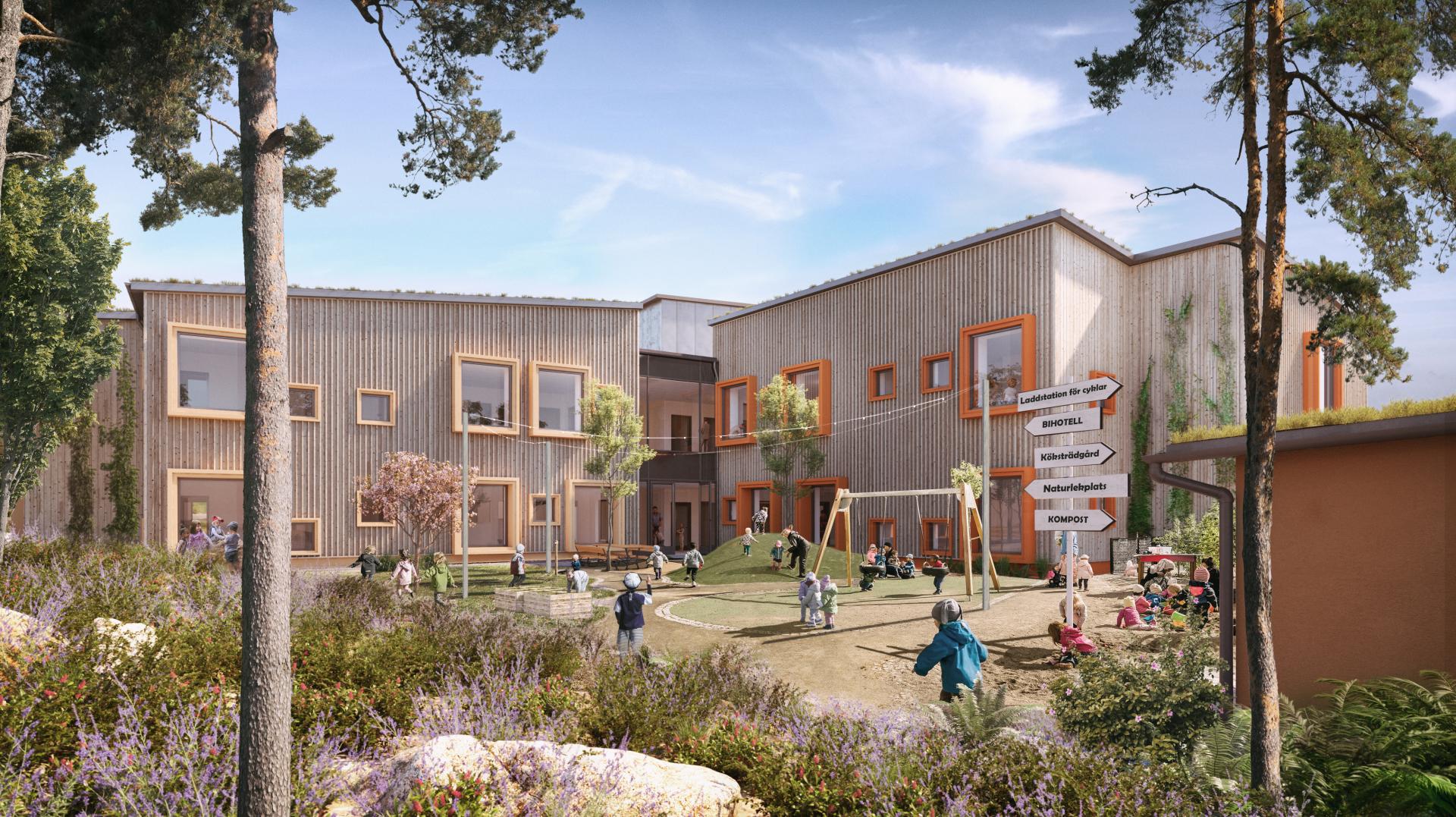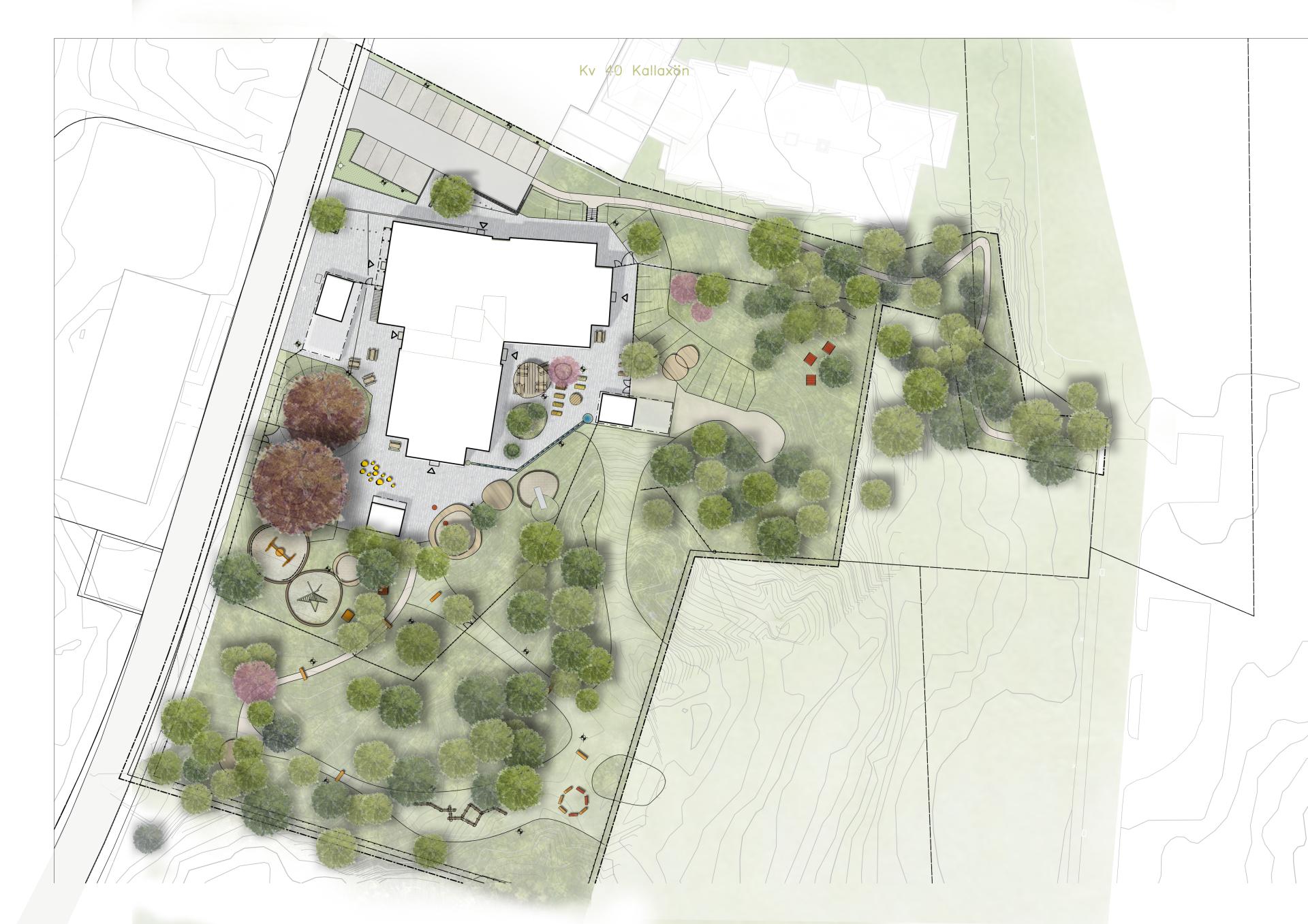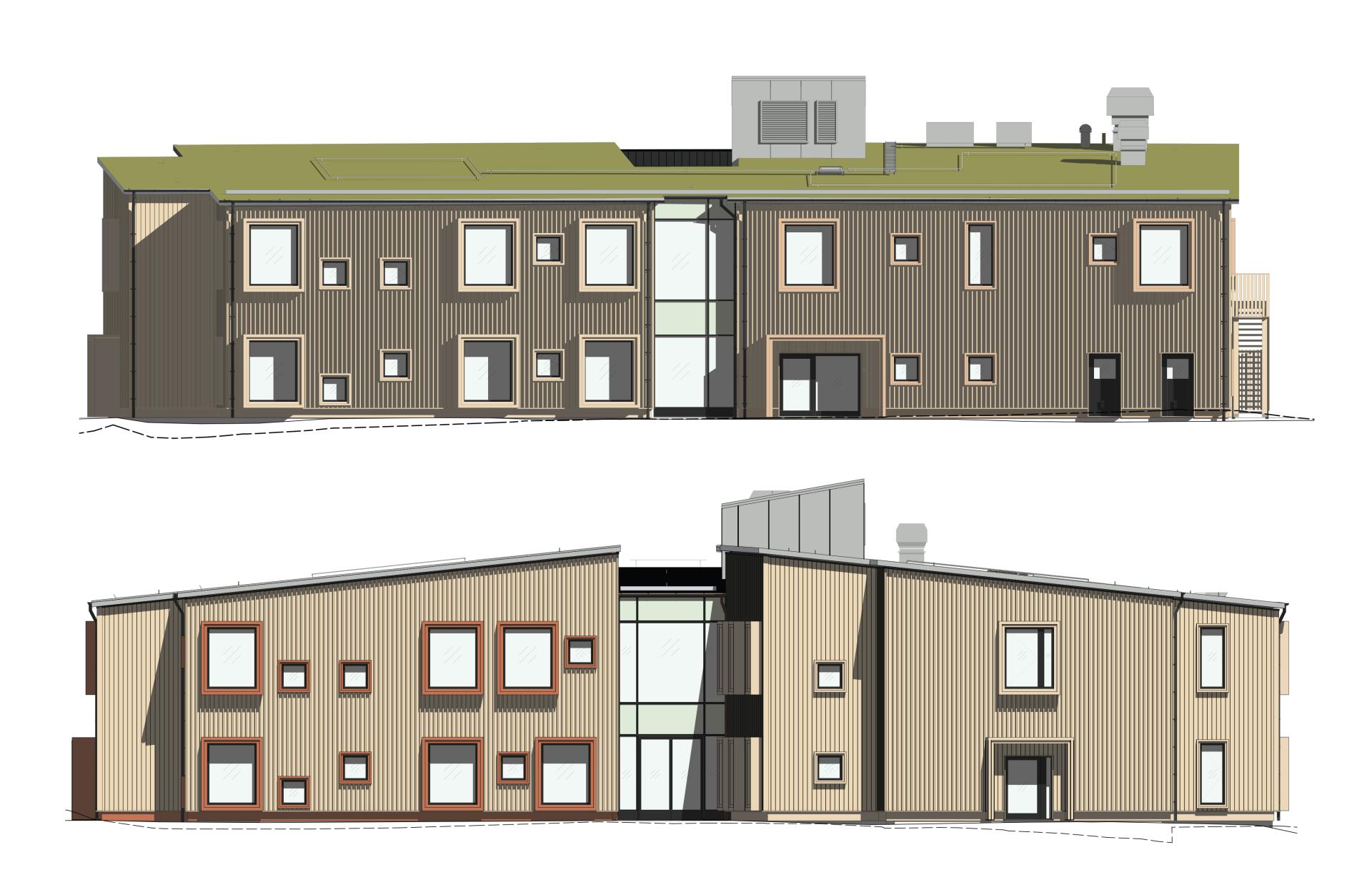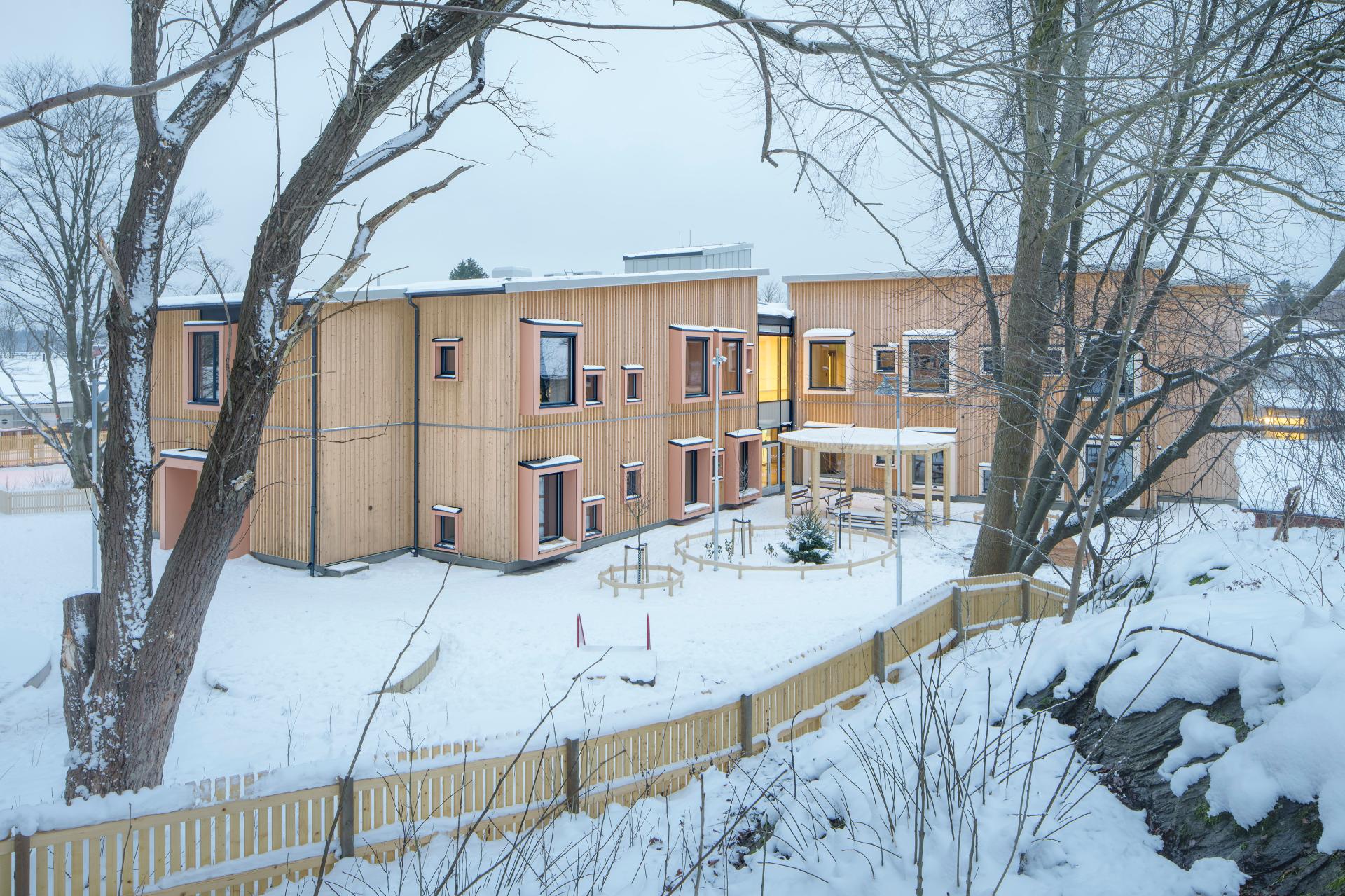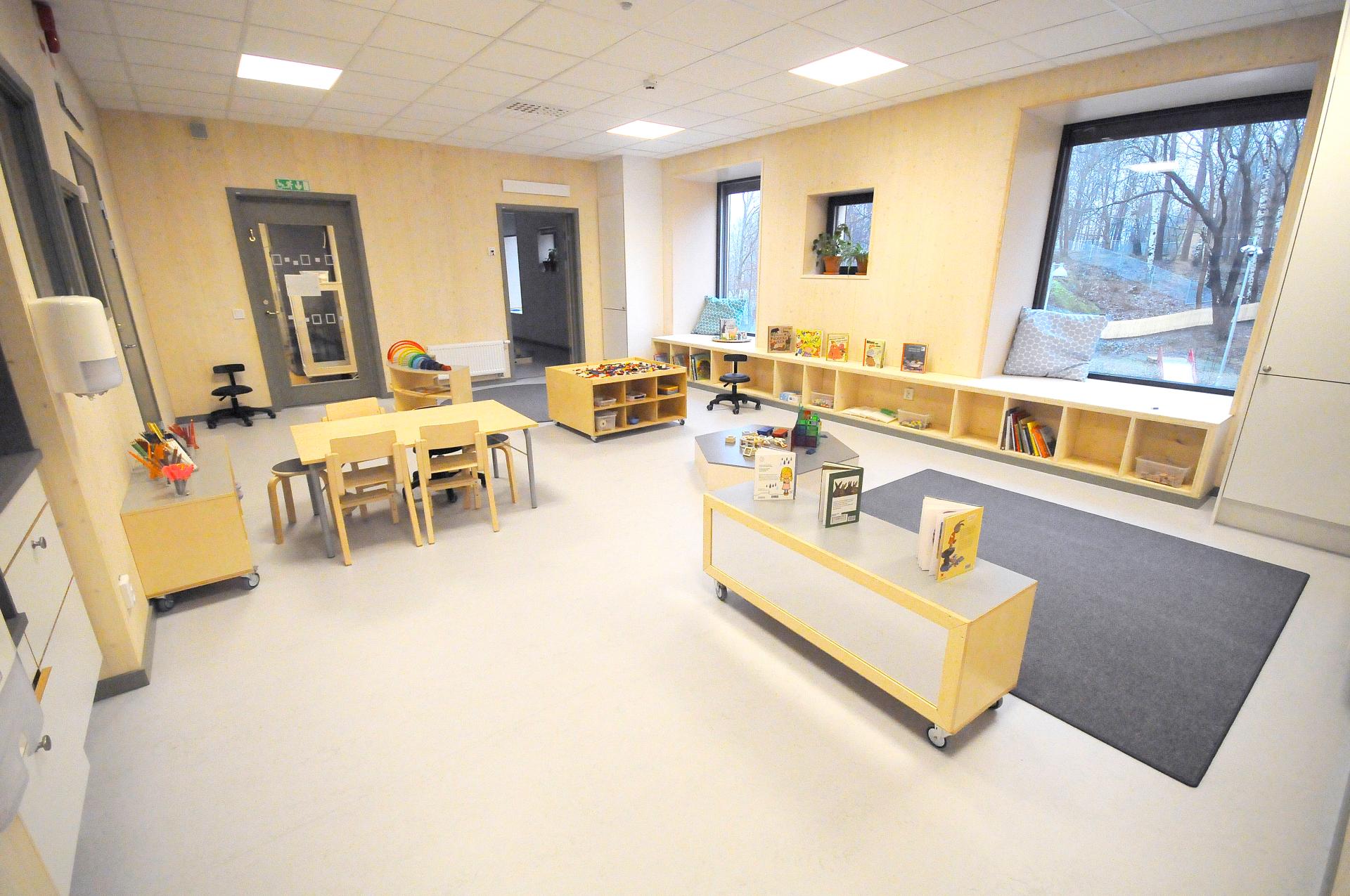Hoppet
Basic information
Project Title
Full project title
Category
Project Description
By reducing its CO2 emissions by 60% compared to current standard methods, Swedish pre-school Hoppet challenges the construction industry to raise its standards for sustainability. The fossil-free ideals, enshrined in its construction process, are included in the pedagogical mission of the pre-school to encourage children to learn how to reduce their own carbon footprint. In this way, Hoppet seeks to instil values of sustainability early on in childhood education.
Geographical Scope
Project Region
Urban or rural issues
Physical or other transformations
EU Programme or fund
Which funds
Description of the project
Summary
When the City of Gothenburg decided to build the pre-school named Hoppet (eng. The Hope/Leap), the aim was to create Sweden’s first fossil free construction project. Hoppet is not only a pre-school, but also a pre-study. Through clever design, Hoppet has managed to reduce its CO2 emissions by 60% compared to current standard methods and it established a blueprint that will be used for all future construction projects in the city. In this way, Hoppet helped us towards achieving our goal of becoming climate neutral by 2030 and challenge cities and stakeholders to make more sustainable choices.
By mapping the CO2 emissions of the entire life-cycle of Hoppet, we knew where to direct our innovation efforts to push forward the forefront of materials research. We also introduced circularity into our value chain; the components of Hoppet have been categorised according to “re-usability” and “chemical content” to make it safe for future re-assemble.
The location of the pre-school was chosen using place-making rhetoric. Hoppet was built in a socially vulnerable area, Hisings-backa, because we knew it would be ground-breaking and we wanted to instil a sense of pride among the citizens of the community. Further, in deciding its exact location, we considered its interactions with existing built environment and surrounding nature. The design of the Hoppet was developed together with building antiquarian to match the 1920s classicism of an adjacent school, Backaskolan, and we preserved the mixed forest at the site to not lose its biodiversity.
Further, the fossil-free ideals enshrined in the construction process have been included in the pedagogical mission of Hoppet. At the school yard, the children can learn how to reduce their own carbon footprint through discussing topics such as: personal waste reduction, material reuse and energy efficiency. In this way, Hoppet seeks to instil values of sustainability early on in childhood education.
Key objectives for sustainability
In 2017, Gothenburg decided to build a pre-school whose entire value chain was fossil-free. This included upstream raw materials, transport, production, construction, and the finished building – which was to be powered using renewable clean energy. The pre-school Hoppet, was the first building using a methodology developed by the city which challenges the construction industry to raise their sustainability standards. This methodology is now incorporated in the city’s innovation program for fossil-free construction.
To reach our objective for fossil-free construction, we developed five strategies: 1) minimising, 2) re-use and re-cycle, 3) bio-based materials, 4) material choices based on life-cycle analysis, and 5) fossil-free construction sites. Under each of these strategies, we adopted targets to feed into our overall objective.
Under strategy 1 and 2, we minimised construction waste and introduced re-used material from storage and other demolition projects around the city. Our objective was that at least one product per discipline should be re-used, which was achieved. The three smaller buildings of Hoppet have foundations made from waste foundation piles while its playground equipment, suspended ceiling and toilet sinks have all been re-used.
To draw inspiration from nature, Hoppet tested different bio-based materials under strategy 3. We decided on using innovative construction materials such as clay, hempcrete and cross-laminated timber, which meant a 60% reduction of CO2 compared to standard methods. It also met our circular criteria of being easy to assemble, disassemble and adapt to a new building in the future.
By using sustainable public procurement, we ensured fossil-free transport to and from the construction site, in line with the objectives under strategy 5. Only ED95, HVO100, RME100 or FAME100/B100, electric or hybrid cars were used to transport the materials, and only working machines with a highest value of 0,44 W/m2 K were allowed at site.
Key objectives for aesthetics and quality
Hoppet set several objectives to ensure its aesthetic. Firstly, the location has a beautiful and rich nature. Therefore, a key objective was to preserve the ecosystems and biodiversity of the area by using non-intrusive construction methods. For example, the building lot was selected specifically to avoid blasting, which also reduced construction related noise pollution and increased the accessibility of the pre-school as no ramps had to be built to allow access. By using large windows, the design is instilled with the idea of never leaving nature, even when indoors, allowing the children and staff to share nature’s seasonal changes. Broad window sills, both inside and outside, provide a place for children to sit and emphasise this idea.
Secondly, to preserve the site’s natural beauty it was important to aesthetically match Hoppet to its built surroundings. Backaskolan, one of the city’s oldest schools built in 1910, was already located at the site. The idea was for Hoppet to build upon this cultural heritage, while using modern construction techniques.
Our objectives in terms of quality of experience are closely linked to the playground design. Given the current densification rate of Gothenburg, it was important that Hoppet gave the children access to an authentic natural outdoor space on its premisses. On the playground, the children can curiously and safely explore their natural surroundings and develop a healthy relationship to nature.
The fossil-free ideals enshrined in Hoppet’s construction process, is also integrated into its pedagogical mission: where both children and parents can learn through “guided play”. Our objective is for families to learn how to reduce their own carbon footprint by discussing topics such as: personal waste reduction, material reuse and energy efficiency. In this way, Hoppet seeks to instil values of sustainability early on in childhood education. We believe this to be crucial to meet the targets of the European Green Deal.
Key objectives for inclusion
While there was no direct co-design process for Hoppet, the design is heavily based on previously conducted research which has used co-design methods together with children to learn what type of pre-school they want. Through the standardised use of the Rebus method, Gothenburg has access to annually updated input from children in terms of what they want from their learning environment. This knowledge is integrated in our general guidelines as it is a part of the democratic and participatory mission of the city. As such, the child perspective has heavily influenced the design of Hoppet.
Research has shown that because nature is gender-neutral, it encourages gender-neutral play. By having a playground with its base in nature, Hoppet not only encourages a healthier relationship with nature, but allows children to freely explore their imagination without the construct of gender conformity influencing their choice of play.
The location chosen for Hoppet means that the pre-school will be servicing the citizens of one of the vulnerable areas of Gothenburg: Hisings-Backa. Not only does this increase accessibility for this vulnerable area to pre-school facilities, but it also gives greater access to environmentally focused pedagogy to communities commonly excluded from green transition measurements.
Hoppet was also build at a location where blasting did not need to take place in order to build the pre-school. A social benefit of this, is that there was no need to create architectural features to make the school accessible, such as ramps or elevators. The pre-school is already accessible due to design.
Given that public pre-school is free of charge in Sweden, inclusion in terms of affordability has not been a factor considered during the project. However, affordability in terms of construction was considered.
Results in relation to category
The building sector comprise 20% of total CO2 emissions in Sweden; construction of buildings accounts for around three quarters of this. Hoppet solves this challenge with clever design and has reduced its climate impact by 60% (including installations) compared to current standard methods.
Hoppet aimed to create transparency across its entire life-cycle. This was achieved through mapping every kilogram of CO2 generated during production, assembly, and operation. Through this exercise, we determined where to focus our innovation efforts to lower our emissions and achieved our goal of building a climate-neutral pre-school.
We aimed to move towards closed material loops and set the goal of introducing one recycled/re-used product per part of the value chain, which was achieved. To increase circularity, Hoppet was designed so that it can be taken apart and re-assembled in the future. According to these criteria we tested new materials and chose clay from the lot that can be reintroduced to the soil. All materials were logged in a digital logbook and categorised according to “re-usability” and “chemical content” to ensure that the building can be safely taken apart.
When designing the school yard we worked strategically with nature-based solutions to create synergy between our three goals to: 1) benefit from ecosystem services, such as reduced heat, 2) provide a green space where the children of Hoppet can explore their relationship with nature and, 3) preserve the biodiversity and natural beauty of the area.
Since Hoppet opened its doors to children in January earlier this year, we are still waiting to see some of its positive social impact. However, the location of Hoppet was chosen based on place-making rhetoric. Hoppet is built in a socially vulnerable area: Hisings-Backa to bring a sense of pride to the neighbourhood, which we can already see signs of.
Hoppet challenges industry to raise the standards for sustainability, aesthetics, and inclusion.
How Citizens benefit
In the design process, children’s suggestions helped shape the school yard of Hoppet. In the City of Gothenburg, the Rebus method has become a standardised process through which children can propose ideas and voice their opinions for the shaping of municipal school yards. This takes place on a yearly basis.
Since Hoppet opened its doors to children in January 2022, we are still waiting to see some of the positive social impacts of the project. However, we have worked to include the lessons learnt from the construction process of Hoppet in the pedagogical mission of the pre-school. This means that children and parents are provided a platform to learn and explore sustainable behaviour and habits. It will take some time before the benefits from this are visible.
During this project, we did not collaborate with any civil society organisations.
Physical or other transformations
Innovative character
Our project looks at Hoppet’s entire life-cycle, from construction and assembly to operation, and has reduced its climate impact by 60% compared to current standard methods (including installations). This includes 80% CO2 savings on the frame and 50% of its foundation. Including storage of biogenic carbon, the construction is entirely climate-neutral. Across its entire value chain, we have introduced 12 innovative components, including soft ventilation ducts and all ground pipes, drainage pipes and cable protection pipes are made from pipe-waste from other buildings and bioplastics.
To achieve this, and to push forward the forefront of materials research, Hoppet has taken part in numerous innovation projects as a case study. Three of them are summarised below.
Hoppet was a pilot for CIX, a tool that stimulates uptake of circular materials in construction projects. CIX was calibrated using the experiences from Hoppet and is now an operational tool that includes guides for recycled and re-used materials and products that can be taken apart and re-assembled.
Further, Hoppet was a case study in the Interreg project “Scandinavian Sustainable Circular Construction” (S2C). The purpose of S2C is to increase uptake of re-used furniture, indoor decorations and design. From Hoppet, we provided our experience of using the city’s own inventory and of re-using products from demolition and reconstruction projects around Gothenburg.
Hoppet is currently participating in a project called ReCirculate, which aims to create methods for cities to grow in a sustainable way. In cities, the potential to re-use already existing materials is large. Research and innovation are therefore important to develop new material flows with increased circularity. It was through ReCirculate, that Hoppet tested and decided upon clay as a construction material.
In this way, Hoppet has collaborated in innovation project as a strategic way of achieving our climate ambitions.
Learning transferred to other parties
Hoppet is not only a pre-school, but also a pre-study for the City of Gothenburg’s innovation programme for fossil-free construction. Our aim with Hoppet was to form a blueprint for all future construction projects in the city, which means that it is carefully documented and easily transferrable. For each step of the process, we developed guides and reports to aid future implementation, that can also be applied outside the city’s borders. The guides are publicly available on the programme platform. Further, the knowledge generated from the innovation projects where Hoppet was a case study, S2C and ReCirculate, has been shared with other project participants and has the potential for broad uptake.
One of the most important lessons of Hoppet is that the climate transition does not have to be costly. Hoppet achieved 60% lower CO2 emissions and was only circa 3-5% more expensive compared to current standard methods. This illustrates how methods and material choices make a tangible contribution, and many of the methods that we used for Hoppet can be transferred to other contexts.
We used a method developed by Swedish Environmental Research Institute (IVL) for calculating the climate impact of Hoppet. We let this guide our innovation efforts; other cities can mimic this approach to determine where they should direct theirs. Other cities can also directly apply the knowledge we generated through circularity index, CIX. Further, to make it possible to take Hoppet apart and re-assemble it in the future, we inventoried all components of Hoppet and labelled them according to “re-usability” and “chemical content” to make them safe for re-use. This approach can also be transferred to other contexts.
Hoppet also pushed forward the forefront of materials research. Here, others can seek inspiration from the materials that we chose, cross-laminated timber, clay found at the lot and hempcrete, and learn from the testing that we performed and the guides that we have developed.

